Smoke on the Water: The Convergence of Strength, Environment and Technique = Speed
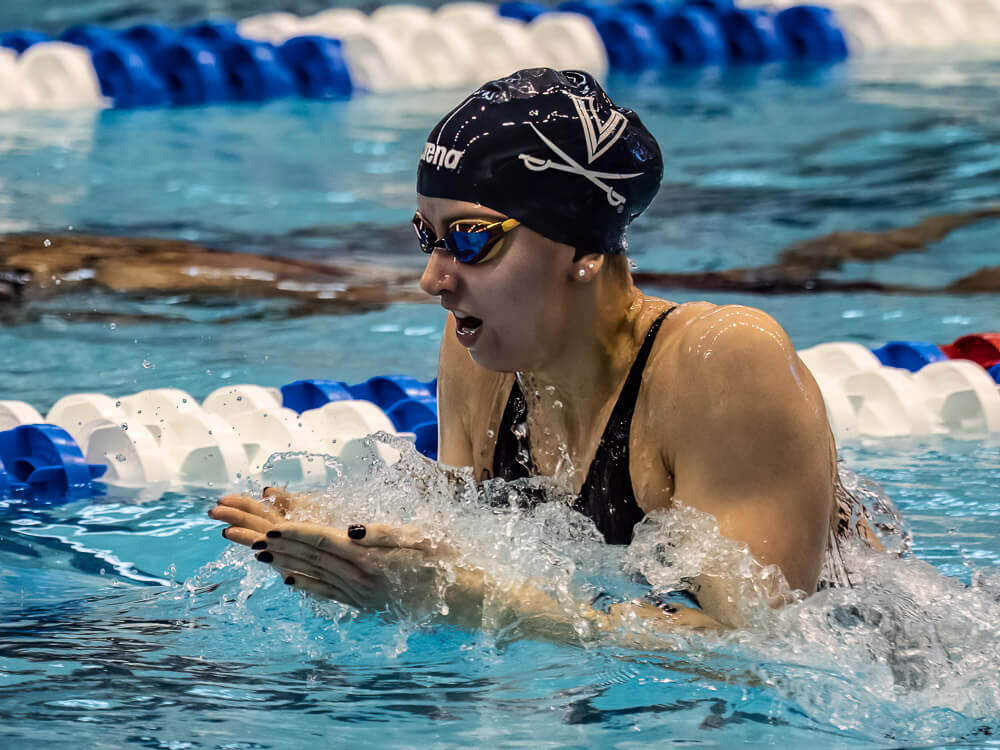
Smoke on the Water: The Convergence of Strength, Environment and Technique = Speed
Point zero one. That was the difference between Florida and Cal in the 400-yard freestyle relay at the men’s 2023 Division I NCAA Championships. Both teams shattered the old record, bringing an emphatic close to a short-course season where athletes of both genders continued to redefine the concept of FAST…and not just in freestyle.
Looking for poster children with versatility?
Go to the University of Virginia and ask for Kate Douglass (three American records in different strokes and distances) or Gretchen Walsh (two records). Or to Tempe, Ariz., and inquire about Leon Marchand’s mind-numbing performances (three records, three NCAA titles).
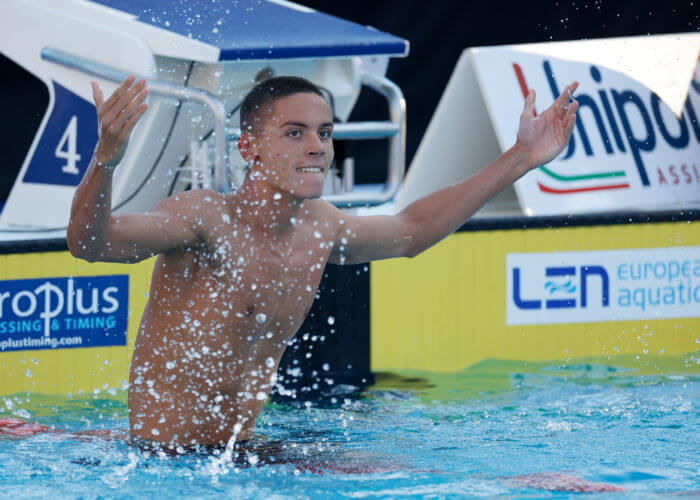
Photo Courtesy: LEN
It’s elsewhere, too. This last year in Europe, David Popovici erased Cesar Cielo’s long-standing 100-meter freestyle world record. The Commonwealth Games aside, Great Britain’s Adam Peaty has seemingly won the 100 breaststroke at every turn. In Australia, Ariarne Titmus, Kaylee McKeown, Emma McKeon, Kyle Chalmers and others elsewhere (Canada’s Summer McIntosh, anyone?) are setting or challenging global speed marks with remarkable frequency.
The truth is really fast swimming, even in season, has been going on for some time now and is not confined to tech suits or world-class athletes. It resides at lower levels—and ages—as well. From September 2022 through March 2023, seven U.S. 15-16 boys’ and five 17-18 girls’ new national age group standards have entered the books. In March at the NCSA Championships, NOVA of Virginia swimmer Nathan Szobota became the fastest 15-year-old ever to swim the 1000-yard free, going a brisk 8:50.44—this from the lad in September who won the World Junior 5K in the Seychelles. Says NOVA coach Mark Kutz, the fast swimming is due to “a lot of things.”
“There is a magic to it,” says Virginia head coach Todd DeSorbo, “but it is not in special sets. The magic is in the environment, in the day-to-day. It is a convergence of coach plan, practice, preparation, athlete ability, work ethic, focus and commitment.”
Throw complementary personalities into a high-energy environment charged with a burning desire to succeed, and you get a magic that produces “insanely fast swimming,” he says. “I am blown away by what Kate Douglass and Gretchen Walsh can do. They are working hard, but they can handle it and swim at a really high level. They also have the ability to go fast all the time.” Also important, adds associate head coach Tyler Fenwick, “we get our swimmers to race every day.”
Some think of fast swimming purely in a sprint context. For sure, there was a lot of spectacular sprinting in college this season. One school with a stellar distance reputation is the University of Florida, which is one reason why Katie Ledecky joined its pro group there. The Gators have also re-imagined their roster to include top-notch shorter distance talent. Caeleb Dressel may have shown the way, but on campus now are Commonwealth Games double medalist and NCAA 100-yard free champion Josh Liendo and CSCAA All-Americans Alberto and Alfonso Mestre, among others.
“I’m getting world-class racing down here regularly, which is great,” says Liendo. “I’ve been doing so much and so often, it’s only going to make me better. We have a large group of guys who can all go fast at any given time and at practices. There’s always someone to push me,” he says. And not always in practice. He’s gotten a steady dose of competition from SEC compatriots Brooks Curry (LSU) and Jordan Crooks (Tennessee.)
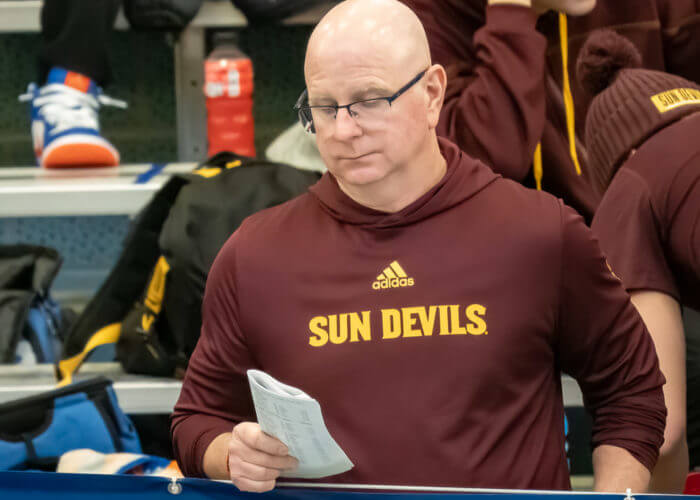
Photo Courtesy: Peter H. Bick
High-powered training groups are not confined to the southeastern United States. Bob Bowman has assembled a lineup that garnered a second-place finish at this year’s NCAAs in March. Not terribly long ago, the Sun Devils were an aquatic afterthought. After not making NCAAs in his first year (2015), Bowman has taken the ASU men—with fast swimming across a wide spectrum of events—from 44th in 2016 to 14th in 2017 to sixth in 2022 and to runnerup in 2023.
SPLASH AND DASH
Back to the 50 free:
The first man to swim the event under 19 seconds (18.74) was Fred Bousquet in 2005. At this year’s D-I meet, 23 of 24 swimmers on the top-six 200 free relay teams—and 34 of 40 on the top-10 teams—swam the 50 under 19 seconds. And lest one think fast swimming is confined to D-I, consider this: In the D-III meet, 18 of 24 200 free relay male swimmers were under 20 seconds. And it’s not just college kids.
Speed lives at the age group level, too. Swimmers from age group programs such as Sandpipers of Nevada, Carmel Swim Club (Ind.), TAC Titans (N.C.) and Elmbrook (Wis.) have garnered national recognition for their new marks and scholarships from welcoming college coaches. In fact, at an age group meet in late March, Nation’s Capital Swim Club’s (Va., Md. and D.C.) Josh Howat became the 28th 15-year-old to break 20 seconds (19.92) in the 50 free.
But, surprise, surprise, it’s not all about the training.
It’s also the swimmers’ belief in self, team and especially “their coaches,” says Larry Laursen, respected international coach and treasurer of the World Swim Coaches Association. “Agreed,” says DeSorbo. “Building a relationship with the coach is extremely important. The coach has to earn the athlete’s trust. None of that is a given. They’ve got to believe in you and what you are telling them to do, and trust it. On the flip side, you have to work well with the athlete and know them well enough, when to back off, when to push harder, know what their mental mindset and emotional status is at any given point. You’ve got to have a really good relationship with the athlete to get peak potential out of them.”
WHAT ELSE?
More emphasis on better nutrition, rest and recovery, digital fitness-measuring devices (such as WHOOP), and a better understanding of swimming science all play a role. So does the fact that better athletes are being attracted to the sport.
But, how about a simpler explanation? “Strength is speed,” says University of Texas coach Eddie Reese.
Back in the mid-to-late aughts, a Mid-Atlantic high school coach worked as a clinician at the University of Arizona summer camps. There he met Penn State assistant coach Jake Shellenberger (now head coach at Liberty University), who persuaded him to watch the Wildcat men and women work out in the weight room. There he saw an ungodly work ethic that was producing perspiration, pumped iron, 52-inch box jumps and strong athletes. Did the work pay off? The following March, the Arizona men and women won national team titles! The high school coach took the message back to his team, where the boys won a state championship. Later, as a follow-up, Shellenberger sent the coach a copy of his book, Power Towers & Swimming: The Guide.
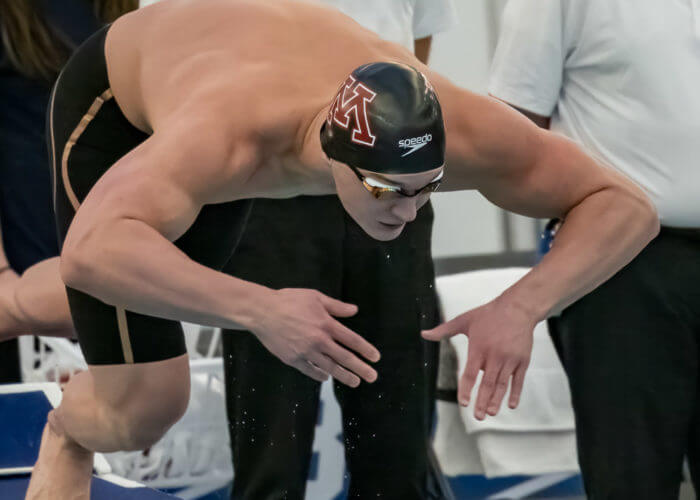
Photo Courtesy: Peter H. Bick
In addition to strength producing fast swimming, it also makes firm physiques. Adam Peaty at 6-3, 209 pounds, and Max McHugh, 6-4, 215 pounds, are both fast and cut. And they are not alone. Virtually any swimmer at NCAA championships or international meets is firm, fully-packed and as strong as can be.
Even those less committed to normal swim training find that strength produces dividends. One age group coach recalls one year how his NISCA All-American compromised in-water training the following year for strength development. The swimmer “got way stronger than he had been and had good championship meets,” says the coach, “but if he’d been training at the level he should have, he’d have been much faster. His gains came from strength.”
All veteran coaches note that building athleticism outside the pool has been on an uptick in recent times. A prime example is the bottom-to-top athlete strength development exemplified by the GAIN Network. Started by Vern Gambetta in 2007, GAIN offers a fully integrated swimming and dryland program for 8-to-18-year-olds. The Network’s offshoot, GAIN Swimming, headed by Chris Webb, now works with more than 20 age group teams nationwide, bringing swim-appropriate dryland and strength training to in-water workouts. One of those is uber successful Carmel Swim Club whose weight room, says Webb, “rivals that of any college.”
Former coach at Carmel and now head man at Dynamo Swim Club in Atlanta, Ian Murray continues his relationship with GAIN, saying “the athletes I work with are healthier and performing better because of GAIN. How I coach people and train athletes has drastically improved because of Vern’s guidance,” he says.
NEW AND IMPROVED
For sure, coaches are employing myriad forms of training unheard of back in the days of mega yardage. “They are using buckets, parachutes, cords and all types of toys to get swimmers to feel the water better and get stronger with their pulls and their kicks. Look at NCSAs, NCAAs and who the winners were,” says NOVA of Virginia’s Kutz. “They are working on speed, underwater kicking, fast turns and power. The sprint events these days are dominated by the people going farthest and fastest underwater, so it’s not necessarily how fast a swimmer is anymore, but how fast a kicker they are. They are only on top of the water 10 yards per 25.
“Andrew Seliskar in 2015 was the first person I saw do that. He dove in, went 15 yards underwater, came up, swam to the wall, went 15 underwater, swam 10 and went 19.7. People learn from that. Coaches see that, go home and find kids who can do that. It’s all over the country. I coach a boy that can kick a 25 in 9.6,” he says.
There are many coaching younger swimmers to fast times. “I think we are living where we want everything for our kids today,” observes Poseidon Swimming’s Ted Sallade. Gregg Troy calls it the age of instant gratification. “You have coaches training their kids more like they do in college versus preparation to do well in college,” says Sallade. “For some, it is a get-all-you-can-while-you-can mentality. That’s why you have 10-and-unders swimming so fast—coaches just keep pushing.”
DROP-DEAD SPRINTERS
Kutz, who has stressed technique for 40 years, has noticed that select drop-dead sprinters have power that supersedes technique. “Some guys are just flat-out powerful. They just turn it over. You don’t really have to be a good swimmer to be fast—just powerful and a really fast kicker. Now…once you get over a 100, you need to flow a bit more. You can’t solely rely on underwater kicking and that tempo anymore—200 and up, you’ve got to be an event swimmer. It’s almost a different sport,” he says.
And that’s where technique really comes in.
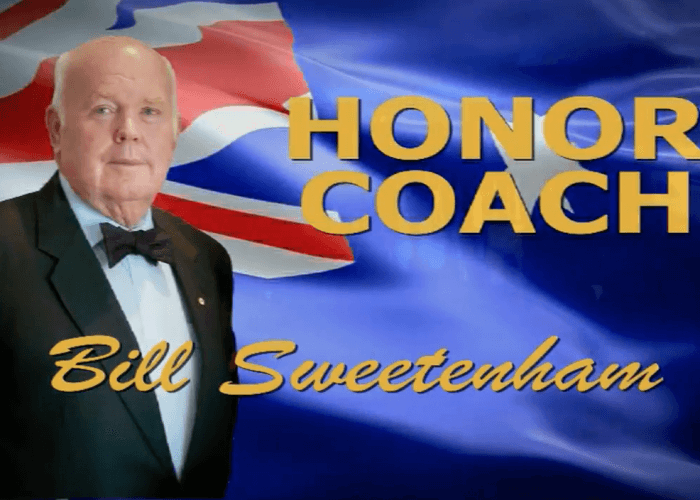
Bill Sweetenham – ISHOF Honor Coach – Photo Courtesy: ISHOF
“Technique is the foundation of speed,” says Webb. In the early aughts, legendary coaches Stephan Widmer and Bill Sweetenham, when working with the British national team, focused on technique and speed at the beginning of the season before stressing endurance training. Using a system Sweetenham dubbed “Anaerobic Approach to Training,” Britain won as many medals at the 2001, 2003 and 2005 World Swimming Championships as it had in all of the previous World Champs dating back to 1973.
Sweetenham is all for fast swimming—just not at the expense of technique and efficiency. In a 50+ global year career, he has witnessed “repeatable occasions where athletes were doing too much and too hard rather than doing too much. They had to learn the difference between speed efficiency and effort,” he says.
More than one Olympic coach agrees. Says Troy, “You cannot swim too fast, but you can sometimes go fast without efficiency. Unfortunately, if this is repeated, it deters from ultimate performance. Repetition of technical efficiency at any speed is vitally important, as is the repetition of correct technique. So is speed, but no more so than efficiency and recovery that can go hand in hand. In short, there are no short cuts,” says Troy.
That means there is still a need for traditional training methods. And that includes a substantial aerobic base. Kyle Chalmers and Nathan Adrian are just two of many world-class sprinters whose respective coaches, Shelly Jarrett and Jay Benner, gave them early aerobic bases.
“The goal is to give them enough work to get better,” says DeSorbo, “but not to overdo it so they slow down or get broken down too much. It’s like the weight room. There is a fine line.”
And when strength, technique and speed converge, fast times are often the result.
* * *
Michael J. Stott is an ASCA Level 5 coach, golf and swimming writer. His critically acclaimed coming-of-age golf novel, “Too Much Loft,” is in its second printing, and is available from store.Bookbaby.com, Amazon, B&N and distributors worldwide.



